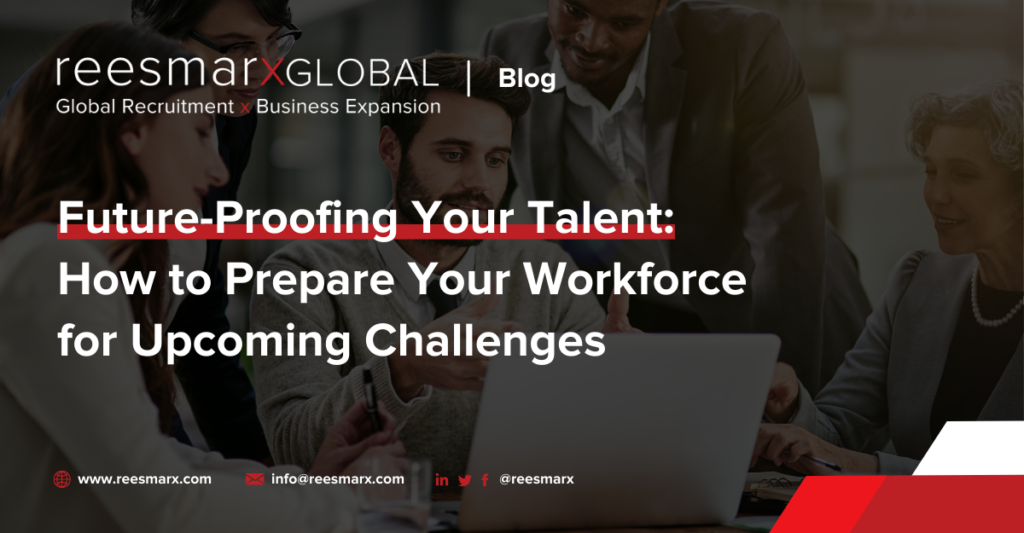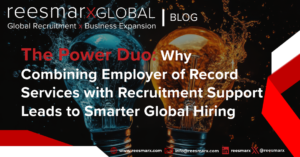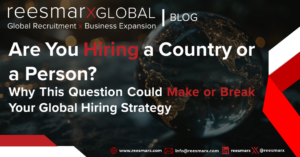In today’s rapidly evolving business landscape, the traditional approach to talent management is no longer sufficient. Organizations must adapt to the changing needs of their workforce and leverage data-driven insights to make informed decisions. Talent analytics offers a powerful tool for organizations to understand their workforce, identify areas for improvement, and drive strategic growth.
By harnessing the power of talent analytics, organizations can gain a competitive advantage and ensure that their workforce is equipped to meet the challenges and opportunities of the future. This blog post will explore the key benefits of talent analytics and provide practical strategies for implementing it in your organization.
The Power of Data: Leveraging Talent Analytics for Strategic Growth
In the face of rapid technological advancements and evolving business landscapes, gut feelings, and outdated information are no longer sufficient to navigate the future of work. Data will play a crucial role in strategic talent planning, enabling organizations to identify skill gaps, track employee progress, and make informed decisions about their workforce.
Harnessing the Power of Talent Analytics
Talent analytics involves collecting, analyzing, and interpreting data related to your workforce. This data can be used to gain insights into a variety of areas, including:
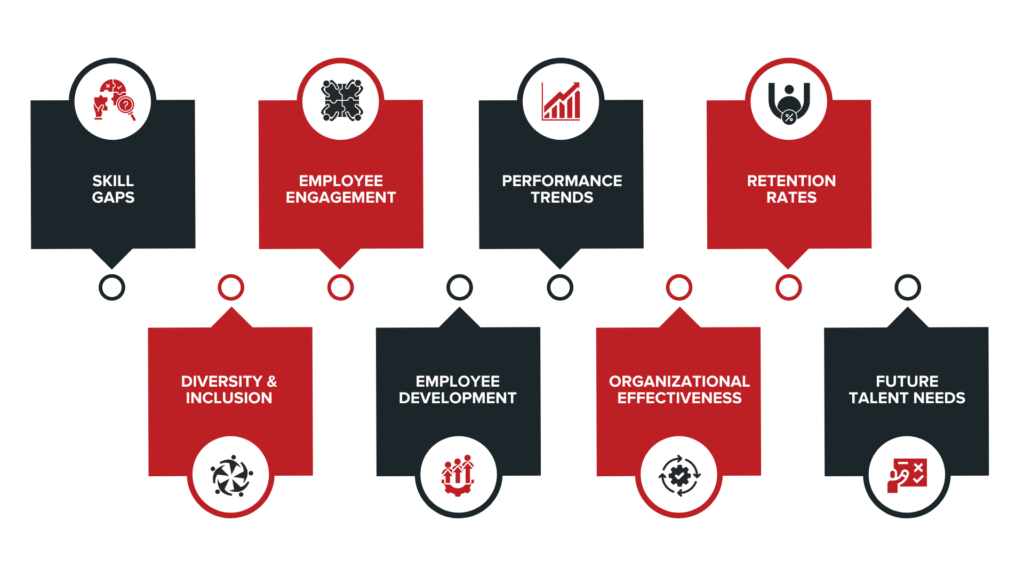
Skill Gaps: Identify the specific skills that your workforce lacks and develop targeted training and development programs to address these gaps. This can help ensure employees have the skills to remain competitive and productive.
Employee Engagement: Track employee engagement levels to identify areas for improvement. This can help create a more positive and supportive work environment, leading to increased productivity, reduced turnover, and improved employee satisfaction.
Performance Trends: Analyze performance data to identify top performers, areas of concern, and potential growth opportunities. This information can be used to reward high-performing employees, address performance issues, and identify areas where additional support is needed.
Retention Rates: Monitor retention rates to identify factors contributing to employee turnover. This can help you address issues driving employees away and create a more positive and supportive work environment.
Diversity and Inclusion: Track diversity and inclusion metrics to ensure your workforce represents the broader population. This can help create a more inclusive and equitable workplace, improving employee morale, innovation, and enhanced reputation.
Employee Development: Track employee development progress to identify areas where additional support or training is needed. This can help you ensure your employees continually grow and develop their skills.
Organizational Effectiveness: Analyze data to assess the effectiveness of your talent management strategies and identify areas for improvement. This can help you optimize your talent management processes and ensure your workforce aligns with your organization’s strategic goals.
Future Talent Needs: Anticipate future talent needs based on industry trends, technological advancements, and organizational goals. This can help you develop strategies to attract and retain the necessary skills to meet your organization’s future requirements.
Leveraging Talent Analytics for Strategic Growth
By leveraging talent analytics, organizations can make more informed decisions about their workforce and drive strategic growth. This includes:
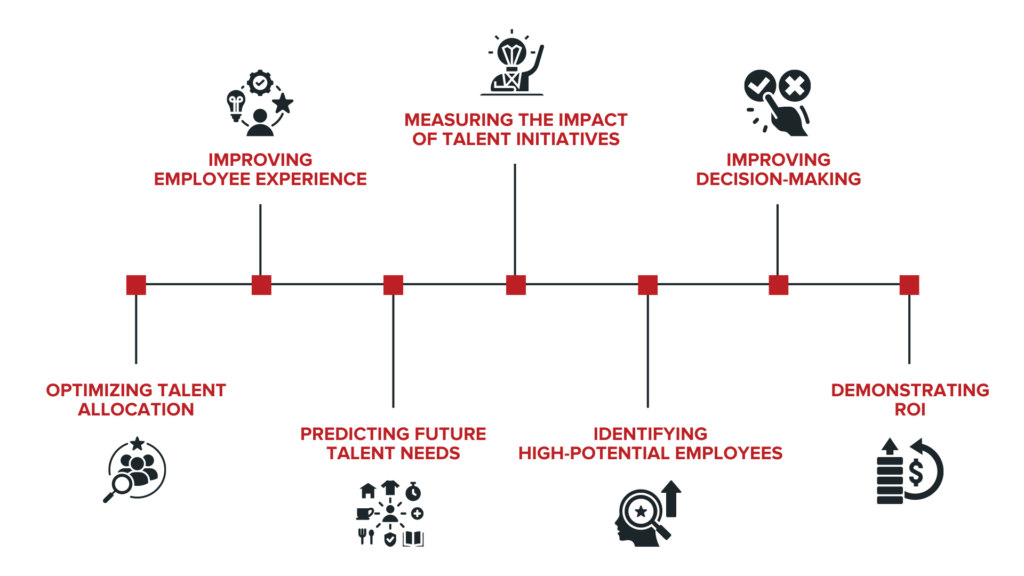
Optimizing Talent Allocation: Assign employees to roles that match their skills and interests, maximizing their potential and productivity. This can help ensure that your employees are engaged and motivated, leading to improved performance and reduced turnover.
Improving Employee Experience: Use data to identify areas where you can improve the employee experience, such as enhancing benefits, providing growth opportunities, or creating a more inclusive workplace. This can help to increase employee satisfaction, engagement, and loyalty.
Predicting Future Talent Needs: Analyze data to anticipate future talent needs and develop strategies to attract and retain the necessary skills. This can help you avoid talent shortages and ensure your organization has the talent it needs to achieve its strategic goals.
Measuring the Impact of Talent Initiatives: Evaluate the effectiveness of your talent management initiatives, such as training programs, performance reviews, and compensation strategies. This can help you identify areas for improvement and ensure that your initiatives deliver the desired results.
Identifying High-Potential Employees: Use data to identify high-potential employees who can become future leaders. This can help you invest in their development and prepare them for leadership roles.
Improving Decision-Making: Use data to inform decision-making related to talent management, such as hiring, promotion, and succession planning. This can help you make more informed and effective decisions.
Demonstrating ROI: Use data to prove your talent management initiatives return on investment (ROI). This can help you justify your investments and secure funding for future initiatives.
By harnessing the power of data, organizations can gain a competitive advantage and ensure that their workforce is equipped to meet the challenges and opportunities of the future. Talent analytics can provide valuable insights into your workforce, allowing you to make data-driven decisions that support your organization’s strategic goals.
Building a Culture of Continuous Learning: Fostering Growth and Adaptability
In the rapidly evolving landscape of the modern workplace, traditional training programs often struggle to keep pace with accelerating technological advancements and industry trends. Cultivating a culture of continuous learning is imperative to ensure your workforce remains competitive and adaptable.
By fostering an environment where lifelong learning is valued and encouraged, you can empower your employees to embrace change, develop new skills, and stay ahead of the curve. Here are some strategies to consider:
- Establish a Learning Ecosystem: Designate a centralized hub where employees can access resources, collaborate on projects, and participate in workshops. This could be a dedicated training room, a shared online platform, or even a designated area in your company's intranet.
- Invest in Cutting-Edge Learning Technologies: Utilize online platforms, microlearning modules, and virtual reality simulations to make learning accessible and engaging. These technologies can provide flexibility and convenience, allowing employees to learn at their own pace and in a way that suits their individual learning styles.
- Offer Flexible Learning Opportunities: Provide options for employees to learn at their own pace, whether through formal training programs, self-paced online courses, or peer-to-peer mentoring. This flexibility can help accommodate your workforce's diverse needs and schedules, ensuring that everyone can participate in learning and development activities.
- Encourage Knowledge Sharing and Collaboration: Create forums, communities of practice, or mentorship programs where employees can share their expertise and learn from others. These initiatives can foster collaboration, innovation, and collective growth.
- Recognize and Reward Learning Achievements: Celebrate employee achievements and milestones related to learning and development. This can include public recognition, awards, or opportunities for career advancement. By acknowledging and rewarding employees for their efforts, you can reinforce the importance of continuous learning and motivate others to follow suit.
- Integrate Learning into Daily Work: Create opportunities for employees to apply new skills and knowledge. This can involve projects, assignments, or cross-functional collaborations that challenge employees to think critically and problem-solve.
- Measure and Evaluate Learning Outcomes: Track employee progress and assess the effectiveness of your learning and development initiatives. This data can help you identify areas for improvement and tailor your programs to meet the specific needs of your workforce.
By prioritizing continuous learning, you’re not just preparing your workforce for the challenges of tomorrow; you’re also investing in their personal and professional growth. A culture of learning can foster a sense of ownership, innovation, and adaptability, which are essential for success in today’s dynamic business environment.
Unlocking Potential: Identifying and Developing Critical Skills for the Future
While technical skills are essential for many roles, focusing solely on these can leave your workforce unprepared for the unexpected challenges and unforeseen opportunities in today’s rapidly changing business landscape. To truly thrive in the future, employees must possess diverse critical skills that go beyond the technical.
Soft Skills: The Hidden Gems of Workforce Success
Soft skills, such as critical thinking, problem-solving, creativity, adaptability, communication, and collaboration, are the hidden gems that can set your employees apart. These skills are in high demand across industries and are becoming increasingly valuable as automation and artificial intelligence reshape the job market.
Identifying Critical Skills for Your Workforce
To determine the specific soft skills that are most important for your organization, consider the following factors:

Industry Trends: Research emerging trends and technologies in your industry to identify the skills that will be in demand in the future.
Company Goals and Objectives: Align your skills development initiatives with your organization’s strategic goals and objectives.
Employee Feedback: Gather feedback from employees, managers, and customers to understand their perceptions of the most critical skills for success.
Developing Critical Skills Through Targeted Training and Development
Once you have identified the critical skills that your workforce needs, you can implement targeted training and development programs to help employees acquire and develop these skills. Consider the following approaches:

Role-Playing and Simulations: Create scenarios that allow employees to practice critical thinking, problem-solving, and decision-making skills in a safe and controlled environment.
Mentorship and Coaching: Pair employees with experienced mentors or coaches who can provide guidance, support, and feedback on their development.
Project-Based Learning: Assign employees to projects that require them to apply their skills and knowledge in real-world situations.
Continuous Feedback and Performance Reviews: Provide regular feedback and performance reviews to help employees identify areas for improvement and celebrate their successes.
Investing in developing critical skills can empower your employees to adapt to change, solve complex problems, and seize new opportunities. A workforce equipped with technical and soft skills will be well-positioned to thrive in the future.

The Future is Flexible: Embracing Agile Work Models for a More Prepared Talent Pool
In today’s competitive job market, rigid work structures can demotivate employees and make attracting and retaining top talent difficult. Organizations must embrace flexible work models to foster a more engaged, productive, and adaptable workforce.
Creating a Flexible Work Environment
Here are some strategies to consider when implementing flexible work arrangements:

Remote Work Options: Allow employees to work from home or other remote locations as long as they can effectively fulfill their responsibilities. This can improve work-life balance, reduce commuting time, and increase employee satisfaction.
Alternative Work Schedules: To accommodate your employees’ diverse needs and preferences, consider options such as compressed workweeks, flexible hours, or job sharing.
Fostering a Culture of Trust and Accountability: Build trust and accountability where employees are empowered to manage their work and deliver results. This can help ensure the success of flexible work arrangements.
Utilizing Technology: Invest in technology that enables remote work and collaboration, such as video conferencing, cloud-based tools, and project management software.
Benefits of Flexible Work Arrangements
Implementing flexible work models can offer numerous benefits for both employees and organizations, including:
- Increased Employee Satisfaction and Engagement: Employees with flexible work arrangements are often more satisfied and engaged. This can lead to higher job performance, reduced turnover, and improved morale.
- Improved Productivity: Flexible work arrangements can help improve productivity by reducing distractions and allowing employees to work during peak hours. This can also lead to increased efficiency and effectiveness.
- Attracting Top Talent: Offering flexible work options can help to attract and retain top talent in a competitive job market. This is particularly important for organizations that want to recruit and retain a diverse workforce.
- Reduced Costs: Flexible work arrangements can help to reduce costs related to office space, commuting, and absenteeism. This can lead to significant savings for organizations, especially those with a large workforce.
- Improved Work-Life Balance: Flexible work arrangements can help employees achieve a better work-life balance by allowing them to manage their personal and professional responsibilities more effectively. This can reduce stress, increase job satisfaction, and improve overall well-being.
- Increased Innovation and Creativity: Flexible work arrangements can foster a more creative and innovative work environment by allowing employees to work on projects at their own pace and in a way that suits their styles. This can lead to new ideas, improved problem-solving, and increased productivity.
By embracing flexible work models, organizations can create a more supportive and inclusive work environment that empowers employees to thrive and contribute to the company’s success.
Building Your Future-Proof Team: Strategies for Hiring and Retention
Traditional recruitment strategies may not be sufficient to attract and retain top talent in today’s competitive job market, especially as employees increasingly prioritize continuous learning and flexible work arrangements. Organizations must adopt a more strategic and proactive approach to hiring and retention to build a future-proof team.
Identifying Talent with a Growth Mindset
When hiring, look for candidates who demonstrate a growth mindset. These individuals believe in their ability to learn and develop new skills and are not afraid to take on challenges. You can identify candidates with a growth mindset by asking questions such as:
What is your biggest professional accomplishment?
How do you handle setbacks or failures?
What are your long-term career goals?
Developing a Compelling Employer Brand
Your employer brand is your company’s reputation as an employer. Developing a strong employer brand that attracts top talent and fosters employee loyalty is essential. This can be achieved by:
Highlighting Your Company Culture: Showcase your company’s values, mission, and vision, and emphasize the positive aspects of working there.
Promoting Your Benefits and Perks: Highlight the competitive benefits and perks that you offer, such as flexible work arrangements, professional development opportunities, and wellness programs.
Leveraging Social Media: Use social media to share positive stories about your company and employees.
Employee Advocacy: Encourage current employees to act as brand ambassadors and share their positive experiences working for your company.
Offering Competitive Benefits Packages
In addition to a strong employer brand, offering competitive benefits packages is essential for attracting and retaining top talent. This includes:
Health Insurance: Provide comprehensive health insurance coverage.
Retirement Savings: Offer retirement savings plans, such as 401(k)s or pension plans.
Paid Time Off: Provide generous paid time off, including vacation, sick leave, and personal time.
Professional Development: Invest in professional development opportunities, such as training programs, conferences, and certifications.
Flexible Work Arrangements: Offer flexible work options, such as remote work, alternative work schedules, or job sharing.
By adopting these strategies, you can build a future-proof team equipped to navigate the challenges and opportunities of tomorrow’s workplace.
Strategic Workforce Planning: Anticipating future skill needs and developing flexible talent acquisition strategies.
Flexible Work Arrangements: Advocating for work flexibility to attract a diverse and agile workforce.
Cultivating a Culture of Adaptability: Ensuring new hires are adaptable and resilient, ready to embrace and drive change.
The role of Talent Acquisition and Executive Search Partners is critical in creating an agile workforce capable of navigating the complexities of the modern business environment. Their strategies ensure the organization remains dynamic, responsive, and ahead of the curve.
Building Your Future-Proof Team: Strategies for Hiring and Retention
In the face of rapid technological advancements and evolving business landscapes, gut feelings, and outdated information are no longer sufficient to navigate the future of work. Data will play a crucial role in strategic talent planning, enabling organizations to identify skill gaps, track employee progress, and make informed decisions about their workforce.
Harnessing the Power of Talent Analytics
Talent analytics involves collecting, analyzing, and interpreting data related to your workforce. This data can be used to gain insights into a variety of areas, including:
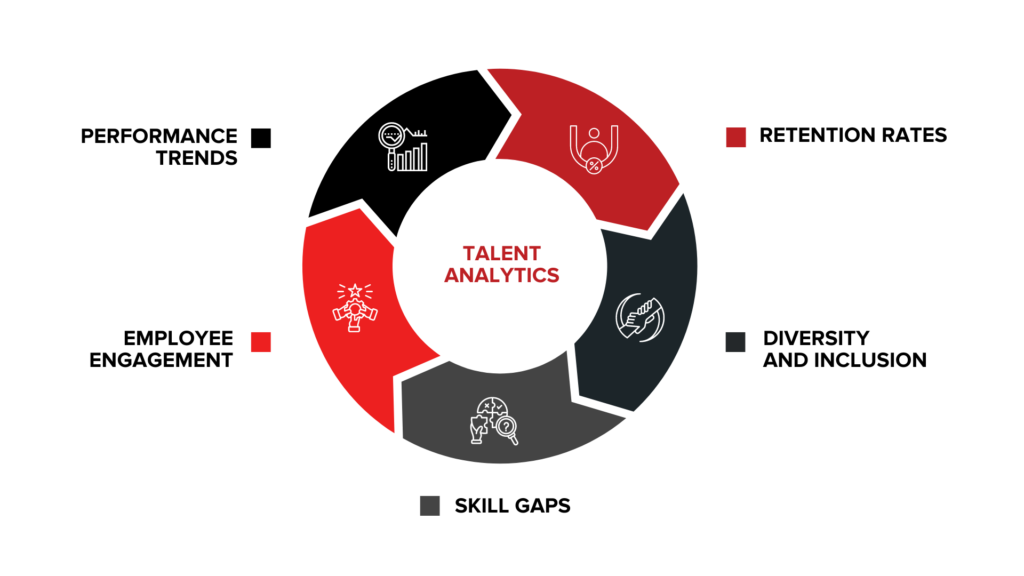
Skill Gaps: Identify the specific skills that your workforce lacks and develop targeted training and development programs to address these gaps. This can help ensure employees have the skills to remain competitive and productive.
Employee Engagement: Track employee engagement levels to identify areas for improvement. This can help create a more positive and supportive work environment, leading to increased productivity, reduced turnover, and improved employee satisfaction.
Performance Trends: Analyze performance data to identify top performers, areas of concern, and potential growth opportunities. This information can be used to reward high-performing employees, address performance issues, and identify areas where additional support is needed.
Retention Rates: Monitor retention rates to identify factors contributing to employee turnover. This can help you address issues driving employees away and create a more positive and supportive work environment.
Diversity and Inclusion: Track diversity and inclusion metrics to ensure your workforce represents the broader population. This can help create a more inclusive and equitable workplace, improving employee morale, innovation, and enhanced reputation.
Leveraging Talent Analytics for Strategic Growth
By leveraging talent analytics, organizations can make more informed decisions about their workforce and drive strategic growth. This includes:

Optimizing Talent Allocation: Assign employees to roles that match their skills and interests, maximizing their potential and productivity. This can help ensure that your employees are engaged and motivated, leading to improved performance and reduced turnover.
Improving Employee Experience: Use data to identify areas where you can improve the employee experience, such as enhancing benefits, providing growth opportunities, or creating a more inclusive workplace. This can help to increase employee satisfaction, engagement, and loyalty.
Predicting Future Talent Needs: Analyze data to anticipate future talent needs and develop strategies to attract and retain the necessary skills. This can help you avoid talent shortages and ensure your organization has the talent it needs to achieve its strategic goals.
Measuring the Impact of Talent Initiatives: Evaluate the effectiveness of your talent management initiatives, such as training programs, performance reviews, and compensation strategies. This can help you identify areas for improvement and ensure that your initiatives deliver the desired results.
By harnessing the power of data, organizations can gain a competitive advantage and ensure that their workforce is equipped to meet the challenges and opportunities of the future. Talent analytics can provide valuable insights into your workforce, allowing you to make data-driven decisions that support your organization’s strategic goals.
Conclusion
In conclusion, talent analytics is essential for organizations that want to thrive in today’s competitive business environment. By leveraging data-driven insights, you can:
Optimize your workforce: Identify skill gaps, improve employee engagement, and enhance performance.
Drive strategic growth: Make informed decisions about talent acquisition, development, and retention.
Gain a competitive advantage: Stay ahead by anticipating future talent needs and adapting your strategies accordingly.
Implementing talent analytics may require significant effort and investment, but the benefits outweigh the costs. By embracing data-driven talent management, you can create a high-performing workforce well-equipped to contribute to your organization’s success.
Contact reesmarxGLOBAL Today
Embrace the strategic potential of your recruitment team by integrating their insights into your business planning and decision-making processes. Recognize their role as business leaders capable of guiding your organization to new heights. By investing in the development and empowerment of Talent Acquisition and Executive Search Partners, your business can unlock unparalleled growth, innovation, and resilience. Let’s redefine the impact of strategic recruitment and chart a course toward a successful and sustainable future.

